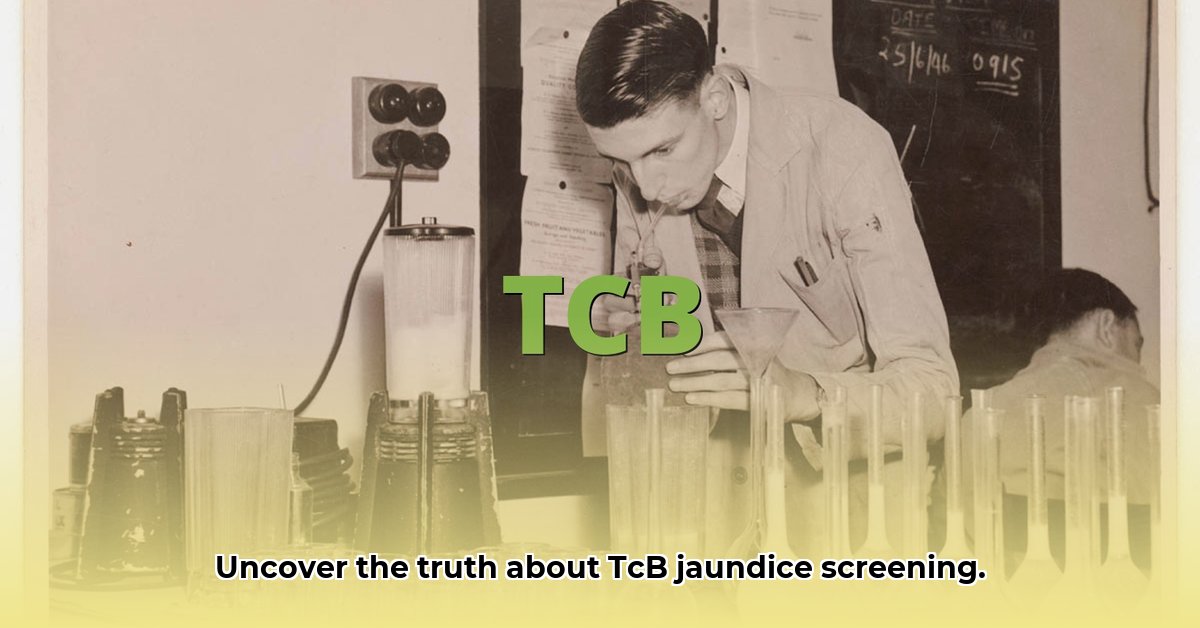Newborn jaundice is a common condition, and its prompt, accurate diagnosis is crucial. While blood tests provide reliable results they involve needles. A transcutaneous bilirubin (TcB) scan is a non-invasive alternative, but how accurate is it, realistically? This review delves into the TcB scan, exploring its advantages and limitations. We’ll examine factors influencing its performance (like the baby’s age and skin tone), compare it to traditional blood tests, and offer guidance on interpreting results and practical tips for optimizing accuracy, especially in premature infants. Our goal is to assist healthcare professionals in leveraging TcB scans effectively, acknowledging their limitations and mitigating them to deliver optimal care for newborns with jaundice. For further guidelines on TcB scans, see these guidelines.
Understanding TcB Scan Accuracy: A Critical Analysis
Let’s examine transcutaneous bilirubin (TcB) scans—devices that estimate bilirubin levels in newborns without requiring blood draws, offering a less invasive approach to neonatal jaundice screening but how reliable are these readings, really?
Transcutaneous Bilirubin (TcB) Measurements Demystified: A Non-Invasive Overview
TcB scans provide a convenient method for screening newborns for jaundice by shining light to estimate bilirubin levels, reducing stress for babies and parents. Studies suggest TcB readings often align with blood tests (total serum bilirubin, or TSB) in healthy newborns, offering a gentler option for jaundice screening. Transcutaneous bilirubinometry works by directing light into the skin and measuring the intensity of the wavelength of light that is returned. The measurement is usually taken by gently pressing the meter against the sternum or forehead.
Factors Influencing TcB Accuracy: Age, Skin Tone, and Bilirubin Level
The accuracy of a TcB scan isn’t absolute; a baby’s age matters a lot, premature babies have thinner skin affecting the scan’s results. Skin tone also impacts accuracy; TcB might overestimate bilirubin in babies with darker skin, even high bilirubin level might cause a less accurate reading. Around 53% to 68% of the time, TcB and TSB tests agreed on whether a baby needed treatment, demonstrating room for improvement. TcB tends to underestimate TSB in light and medium skin colors and overestimates in dark skin color.
Addressing TcB Limitations: Research and Technological Advancements
The variability in TcB accuracy requires further investigation, demanding more inclusive research using a range of babies to assess prematurity, skin tone, and bilirubin levels. Here’s what researchers are focusing on:
- Smarter Software: Developing software that adjusts readings based on a baby’s age can enhance reliability. This is like, special calculator that takes the baby’s age into account before giving a final number.
- Skin Tone Consideration: Further research is needed to fully understand how the skin tone impacts the reading. This is essential to ensure fair and accurate results for all infants.
- Expanded Bilirubin Range: Data collection is needed for the full range of bilirubin levels to provide a clearer picture.
Economic Considerations: TcB Cost-Benefit Analysis in Neonatal Care
TcB scans can bring cost savings due to fewer blood tests, leading to lower medical costs. However, significant savings might not materialize if a hospital already conducts numerous blood tests. Weighing costs and savings is essential to determine the optimal approach. Transcutaneous bilirubin measurement has been recommended as a more cost‐effective and less traumatic method of measuring bilirubin levels in newborns.
Risk Assessment: Comparing TcB and Traditional Blood Tests
Here’s a glimpse at the advantages and disadvantages of both approaches:
| Technology/Method | Potential for Inaccurate Results | Risk of Infection/Injury | Cost |
|---|---|---|---|
| Traditional TSB (Blood) | Low (if done correctly) | Moderate | Relatively High |
| TcB (Transcutaneous) | Moderate (especially preterm) | Low | Lower |
TcB is less invasive and cheaper, but it’s more likely to yield inaccurate results, particularly in premature babies. Chemical methods for serum bilirubin measurement is currently the reference standard for measuring bilirubin levels. However, this requires repeated blood sampling which can be painful to the newborn, costly and time consuming.
Collaborative Efforts: Enhancing TcB Reliability and Performance
Improving the accuracy of TcB scans requires a team effort:
- Doctors and Nurses: Conducting more studies and participating in larger trials to confirm the accuracy of the TcB.
- Hospital Administrators: Comparing the costs of using TcB to the costs of doing blood tests.
- Policy Makers: Using this evidence to update guidelines and recommendations for hospitals.
- Tech Companies: Developing better TcB devices and software.
Regulatory agencies ensure these devices are safe and accurate, while improving TcB accuracy is an ongoing journey. Further research and enhanced technology are crucial to unlocking its full potential in helping newborns. For now, it’s crucial to remember its limitations, especially with preterm infants.
Optimizing Transcutaneous Bilirubin Readings in Preterm Infants: A Practical Guide
Key Takeaways:
- Transcutaneous bilirubin (TcB) testing offers a convenient, non-invasive alternative to traditional serum bilirubin (TSB) tests for neonatal jaundice.
- However, TcB accuracy varies significantly depending on the infant’s gestational age (GA). Preterm infants present a unique challenge.
- This variability necessitates careful interpretation of results and, in many cases, confirmation with TSB.
- Research is ongoing to refine TcB technology and develop algorithms to improve accuracy, particularly in preterm newborns.
Unique Challenges of TcB Measurements in Preterm Infants
TcB is less accurate in preterm babies due to factors such as thinner skin, differing bilirubin-albumin binding capacities, and skin conditions.
Methods for Correcting Bilirubin Readings for Premature Babies
There’s no universally accepted correction method; research suggests using gestational age (GA) as a correction factor when interpreting results.
Clinical Protocols: Implementing Best Practices Using TcB
Proper device calibration and maintenance are essential and results need to be carefully interpreted. Using TSB testing to confirm TcB readings is often necessary, especially for preterm infants with high bilirubin levels. Newborns are routinely monitored by nursing staff and physicians for the development of jaundice in the first few hours of life and before discharge from the newborn nursery. This is usually done by visual inspection and skin blanching to assess for yellowish discolouration. Visual estimation of bilirubin level is not reliable. Therefore, bilirubin level needs to be assessed objectively by means of a TcB or TsB measurement.
Future Research: Advancing TcB Technology for Preterm Neonates
Validate existing algorithms and develop more refined ones by establishing optimal GA-specific correction factors for TcB devices to improve reliability.
Comparison of a new transcutaneous bilirubinometer (Bilimed®) with serum bilirubin measurements in preterm and full-term infants
Guidance Note
This information is for educational purposes only; consult with a medical professional for health concerns.
Analyzing TcB Accuracy in Preterm Infants Based on Skin Pigmentation
Key Takeaways:
- TcB, a promising non-invasive method, shows variable accuracy in preterm infants.
- Skin pigmentation significantly impacts TcB readings. Darker skin tones often lead to underestimation of bilirubin levels.
- Preterm infants, especially those with darker skin, may require more frequent serum bilirubin (TSB) testing.
- Phototherapy interferes with TcB accuracy.
- Further research is needed to refine TcB technology and protocols for preterm infants.
Understanding TcB Measurement Variability
Serum bilirubin (TSB) testing is the gold standard, but invasive. Transcutaneous bilirubin (TcB) offers a non-invasive alternative. The accuracy of TcB in preterm infants with varying skin tones raises concern.
Gestational Age and Skin Pigmentation Impact
Darker skin tones lead to underestimation of TSB levels using TcB, thus gestational age decreases TcB accuracy which requires adjustments.
Phototherapy Complications During TcB Screening
Phototherapy interferes with TcB measurements, leading to underestimation of TSB levels—better ways should be established.
Clinical Practice Considerations for TcB Use
Clinicians need to carefully consider infant’s gestational age and skin pigmentation, potential interference from phototherapy, as well as the need for TSB testing. The bilirubin levels are interpreted based on the infant’s gestational age and postnatal age.
Advancing Further TcB Technologies
Scientists are working to enhance TcB technology adjusting algorithms to minimize bias from gestational age and skin pigmentation.
Urgent Call to Further Investigation
We need a collaborative effort by developing improved TcB algorithms and conduct more comprehensive studies that account for gestational age, skin tone, and phototherapy. Also, regulatory bodies should establish guidelines for patient populations.
How Accurate is TcB Scan for Neonatal Jaundice? A Comprehensive Review
Examining the Cost-Effectiveness of TcB Screening Across NICU Environments
Key Takeaways:
- Transcutaneous bilirubin (TcB) screening offers a potentially cost-effective alternative to traditional serum bilirubin (TSB) tests for neonatal jaundice.
- TcB’s accuracy varies depending on factors like gestational age (GA), birth weight, and race. It’s less accurate in very preterm infants.
- While
- Water Wheel Electric Generator Provides Free Home Electricity - December 15, 2025
- Choosing the Right Portable Hydro Turbine for Your Needs - December 14, 2025
- Best Portable Hydro Generators for Off-Grid and Outdoor Power - December 13, 2025















